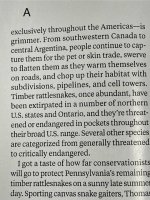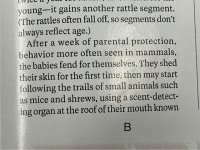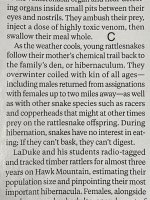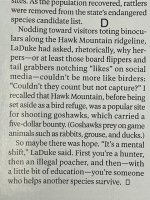Martin Nowak
Active member
“Love, Hate, and Rattlesnakes”
National Geographic December 2024
By: Elizabeth Royte https://www.royte.com/
Elizabeth Royte Contact: eroyte (at) yahoo.com
The article should appear on her website in due time.
I am not placing a link to the article here since it’s paywall protected.
However, four pics from the story are included and noted in my comments.
As I began reading, I thought “perhaps this article will be fair and offer balanced discussion”. Of course, being NatGeo, I was disappointed in my initial thoughts, but not surprised. I concluded this article is another crappy biased narrative by uninformed author. The academics she quotes do not positively reflect on reptile keepers.
The story offers some good biology about rattlesnakes including a north and south American map with rattlesnake ranges and projected density by geographic area.
The story is harsh on rattlesnake rodeos and in particular castigates the Sweetwater Texas rodeo with a number of pictures and brief interviews.
The story has a picture of El Paso snake breeder Kyle Vargas with a banded rock rattlesnake. Also included is cropped picture of an albino prairie rattlesnake without explanation or comment.
Pic A
“… capture for the pet trade …”
No explanation or distinction of the pet trade (rattlesnakes ?) and reptile keepers / breeders. There is no discussion about rattlesnake breeders and the legitimate industry.
Pic B
“… parental protection …”
This is a pet peeve of mine. This article notes parental protection in an active sense. Much like the rattlesnake cam professor uses the term “maternal care”. I see parental protection in cobras and pythons guarding eggs for example. Or crocodilians protecting eggs and young. And some amphibians protecting eggs and young. This year I watched the rattlesnake cams for hours – especially the Colorado one. A couple times I saw a bird (I think a black-billed magpie) drop in, walk around the neonate rattlesnakes and even peck at one or two. No adult chased off the bird or struck at it. Bees landed on the adults who flexed a muscle to knock it off. When bee(s) landed on neonates clearly irritating them no adult came to the rescue. Perhaps a more experienced rattlesnake keeper could talk about “maternal” or “parental” care by rattlesnake females.
Pic C
“… racers and copperheads that might at other times prey on the rattlesnake offspring.”
Any keeper factually aware of a racer or copperhead eating neonate timber rattlesnakes in the northeast U.S. ?
Pic D
“… why herpers – or at least those board flippers and tail grabbers notching “likes” on social media – couldn’t be more like birders: … count but not capture? … First you’re a hunter, then an illegal poacher, and then – with a little bit of education – you’re someone who helps another species survive.”
Exasperating that the author calls and lumps herpers, board flippers, and tail grabbers in with illegal poachers (are there legal poachers?). One must admit that a part of her position must be attributed to the stupid reptile keepers who free handle venomous snakes, post pics of same, gleefully demonstrate the manner of handling hots. And others in the hobby who tolerate and even endorse such behavior. It does not help the industry at all.
National Geographic December 2024
By: Elizabeth Royte https://www.royte.com/
Elizabeth Royte Contact: eroyte (at) yahoo.com
The article should appear on her website in due time.
I am not placing a link to the article here since it’s paywall protected.
However, four pics from the story are included and noted in my comments.
As I began reading, I thought “perhaps this article will be fair and offer balanced discussion”. Of course, being NatGeo, I was disappointed in my initial thoughts, but not surprised. I concluded this article is another crappy biased narrative by uninformed author. The academics she quotes do not positively reflect on reptile keepers.
The story offers some good biology about rattlesnakes including a north and south American map with rattlesnake ranges and projected density by geographic area.
The story is harsh on rattlesnake rodeos and in particular castigates the Sweetwater Texas rodeo with a number of pictures and brief interviews.
The story has a picture of El Paso snake breeder Kyle Vargas with a banded rock rattlesnake. Also included is cropped picture of an albino prairie rattlesnake without explanation or comment.
Pic A
“… capture for the pet trade …”
No explanation or distinction of the pet trade (rattlesnakes ?) and reptile keepers / breeders. There is no discussion about rattlesnake breeders and the legitimate industry.
Pic B
“… parental protection …”
This is a pet peeve of mine. This article notes parental protection in an active sense. Much like the rattlesnake cam professor uses the term “maternal care”. I see parental protection in cobras and pythons guarding eggs for example. Or crocodilians protecting eggs and young. And some amphibians protecting eggs and young. This year I watched the rattlesnake cams for hours – especially the Colorado one. A couple times I saw a bird (I think a black-billed magpie) drop in, walk around the neonate rattlesnakes and even peck at one or two. No adult chased off the bird or struck at it. Bees landed on the adults who flexed a muscle to knock it off. When bee(s) landed on neonates clearly irritating them no adult came to the rescue. Perhaps a more experienced rattlesnake keeper could talk about “maternal” or “parental” care by rattlesnake females.
Pic C
“… racers and copperheads that might at other times prey on the rattlesnake offspring.”
Any keeper factually aware of a racer or copperhead eating neonate timber rattlesnakes in the northeast U.S. ?
Pic D
“… why herpers – or at least those board flippers and tail grabbers notching “likes” on social media – couldn’t be more like birders: … count but not capture? … First you’re a hunter, then an illegal poacher, and then – with a little bit of education – you’re someone who helps another species survive.”
Exasperating that the author calls and lumps herpers, board flippers, and tail grabbers in with illegal poachers (are there legal poachers?). One must admit that a part of her position must be attributed to the stupid reptile keepers who free handle venomous snakes, post pics of same, gleefully demonstrate the manner of handling hots. And others in the hobby who tolerate and even endorse such behavior. It does not help the industry at all.





